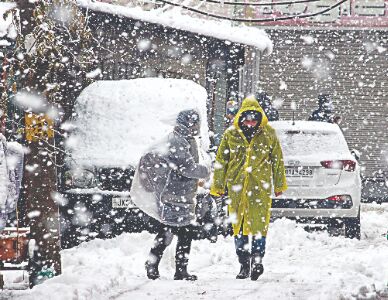Several parts of north India witness rains, above-normal temperatures

New Delhi: Several parts of north India witnessed light to moderate rains due to a western disturbance and above-normal temperatures on Monday, the India Meteorological Department (IMD) said.
Once the western disturbance withdraws, the mercury is likely to dip again, it added.
The western disturbance is causing widespread snowfall in the hills. Once it withdraws, the mercury will fall again to four to five degrees Celsius, the IMD said. Light rain and snowfall were witnessed in some parts of Himachal Pradesh in the last 24 hours, officials said.
Kalpa received 1 mm snowfall, while Dharamshala witnessed 2.2 mm and Saloni 2 mm rain, they added.
The Shimla Met centre has issued a "yellow" warning for thunderstorm, lightning in the plains and low hills, and for heavy rain and snowfall in the mid-hills on Tuesday. It has issued an "orange" warning for heavy snowfall in the high hills on January 5.
The tribal district of Lahaul and Spiti's administrative centre Keylong continued to be the coldest place in the state at minus 4.5 degrees Celsius. Kalpa in Kinnaur district recorded a low of minus 1.6 degrees Celsius.
Kashmir was cut off from the rest of the country on Monday as the arterial Jammu-Srinagar national highway and the Mughal road were closed due to snowfall across the valley, leaving nearly 4,500 vehicles stranded. An official of the traffic control department said snow-clearance operations were in full swing and efforts were on to restore the movement of the stranded vehicles along the 260-kilometre Jammu-Srinagar national highway.
The official said nearly 4,500 vehicles, mostly trucks carrying essentials to the valley, are stranded at various places along the highway. South Kashmir's Kulgam district received the highest snowfall in the Union Territory with two to three feet of snow accumulated at some places, the official said.
Flight operations to and from Srinagar remained suspended for the second consecutive day due to poor visibility.
The minimum temperature improved at most places in the valley due to the snowfall but still stayed below the freezing point, officials said.
The MeT office said moderate to heavy snowfall with isolated very heavy snowfall is most likely to take place, especially in south Kashmir, Gulmarg, Banihal-Ramban, Poonch, Rajouri, Kistawar and Zanskar, Drass as well as on the higher reaches of Ladakh, for two days
from Monday.
Most parts of Haryana and Punjab recorded above-normal minimum temperatures, an official said. Chandigarh, the joint capital of the two states, recorded a low of 12.5 degrees Celsius, seven notches above normal, the official said.
In Haryana, Ambala recorded a minimum temperature of 11.2 degrees Celsius, Hisar 9.4 degrees Celsius and Karnal 10.5 degrees Celsius
In Punjab, Amritsar, Ludhiana and Patiala recorded a low of 11 degrees Celsius, 13.4 degrees Celsius and 12.5 degrees Celsius respectively, up to eight notches above
normal.
Some places in Punjab received rains the previous day. Among them are Amritsar (2.2 mm), Ludhiana (1.7 mm), Pathankot (16 mm), Adampur (0.8 mm) and Gurdaspur (6.7 mm).
Light to moderate rainfall triggered by the western disturbance was recorded at some places in Rajasthan. Sawaimadhopur recorded 43 mm precipitation, followed by Kota (15.7 mm), Bundi (14 mm), Jaipur (seven mm) and Chittorgarh (four mm) in the 24 hours ending at 8.30 am on Monday, officials said.
However, the night temperatures increased by a few notches. Pilani was the coldest recorded place in the state with a minimum temperature of 4.3 degrees Celsius. Jaisalmer, Bikaner and Barmer recorded their minimum temperatures at 7.4, 9.4 and 9.8 degrees Celsius respectively.
Light to moderate rain coupled with thundershowers occurred at many places in Uttar Pradesh.
According to the meteorological department, state capital Lucknow recorded a minimum temperature of 14.6 degrees Celsius, while Allahabad recorded a low of 13.6 degrees Celsius.
Meanwhile, extreme weather conditions led to the death of more than 1,565 people last year with thunderstorm and lightning claiming the lives of 815 of them, the India Meteorological Department (IMD) said on Monday.
Bihar lost the maximum number of 379 lives due to flood, thunderstorm, lightning and cold wave, followed by Uttar Pradesh (356), it said in a report.
Further more, the year 2020 was the eight warmest since 1901 but it was "substantially lower" than the highest warming observed in 2016, the India Meteorological Department (IMD) said on Monday.
During the year, annual mean land surface air temperature averaged over the country was 0.29 degree Celsius above normal (based on the data of 1981-2010)," the IMD said in a statement on Climate of India during 2020.



